Sales prospecting is dead.
*Dramatic pause*
Kidding (obviously).
Deals don’t just fall into your lap – if they do, tell me how.
Prospecting is an essential part of your process.
Without it, you’re stuck waiting for things to happen.
And that’s not a strategy, that’s just dumb luck.
That’s why I stole these 10 prospecting techniques from the best-of-the-best sales pros.
Even if you only master one of these pipeline-building techniques and you’ll end the month with more meetings booked (and close the quarter on the right side of quota).
But first, let’s make sure we’re on the same page.
What is sales prospecting?
Sales prospecting is the process of identifying and engaging with buyers to generate new business. It’s the first step in the sales process. Get it right, and you’ll book more meetings (and top the sales leaderboard in no time).
Outbound prospecting is when sales reps directly engage with prospects. The reps are the ones who initiate the conversation. Examples of outbound sales include making cold calls and sending cold emails.
However, outbound prospecting isn’t easy because you’re reaching out to prospects “cold,” meaning they haven’t expressed interest in your company.
That said, it can work for your company — if you do it right.
Don’t worry; we’ll get there soon.
What are the steps in the sales prospecting process?
We can break the sales prospecting process down into three steps: Research, Qualify, and Outreach.
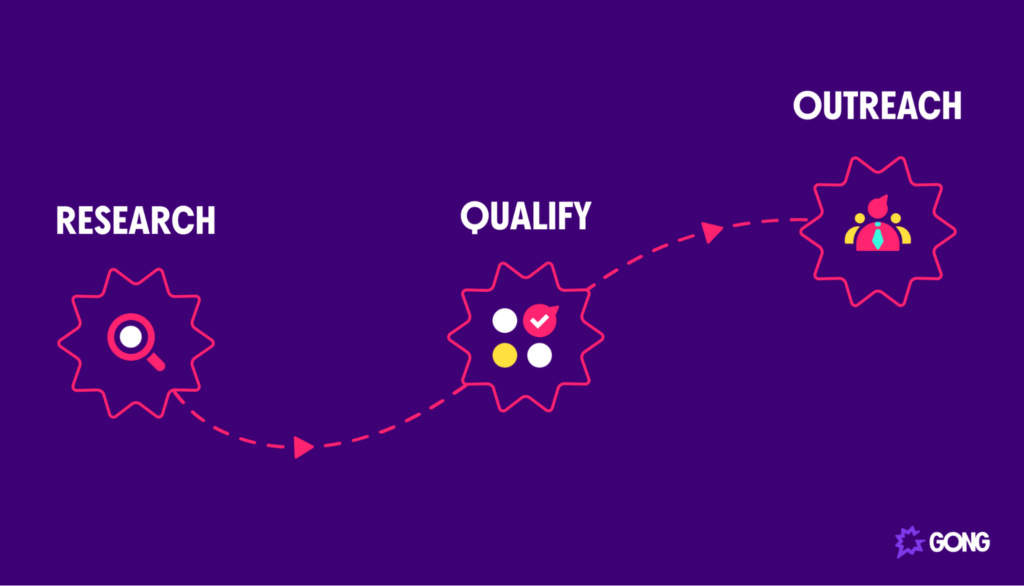
Here’s a quick overview before we dive into sales prospecting techniques.
Research
Making cold calls isn’t easy.
Prospects don’t know who you are. The fact that you’re a complete stranger means they have little to no reason to trust you.
The good news is you can bridge this credibility gap with research — the first (and arguably most important) step of the sales prospecting process.
Research entails learning as much as you can about your prospects before you make contact. It means getting answers to questions like:
- What are the prospect’s pain points?
- What problems are they having?
- How do they currently do things?
Proper research will make your outreach efforts far more successful.
Outreach
Outreach involves reaching out to prospects through various outreach channels, like phone, email, and social media sites like Facebook or LinkedIn.
But you can’t just “wing it” and expect prospects to trust you. Buyers today are inherently skeptical, and sales reps are an unknown quantity.
That is why research is so important.
The more you know about your prospects, the more you can personalize your outreach efforts around their pain points and position your products or services as the solution.
Qualify
Not all prospects are a good fit, and trying to convince those who aren’t only wastes time.
Qualification is all about asking the right sales qualifying questions to determine if a prospect is worth pursuing. It allows your reps to focus on prospects who are more likely to convert.
Another way to qualify prospects is to compare them against your ideal customer profile (ICP) — a list of attributes that define the type of company that would benefit most from your solution.
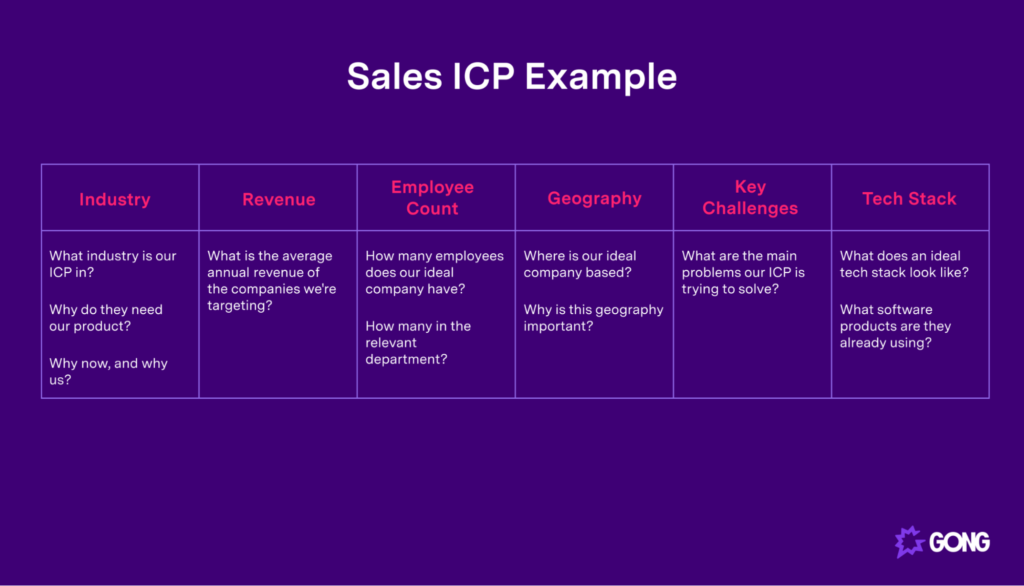
With an ICP, reps can hone in on prospects who are likely to convert based on historical data (e.g., maybe finance companies with over $10 million in revenue convert better).
Now let’s look at how you can use these proven sales prospecting techniques to engage your prospects and book more meetings.
Technique #1: Use This Cold Call Opener
Want to totally level up your prospecting game?
Here’s a tip: Start your sales calls with this cold call opener:
How’ve you been?
Here’s how it works:
“Hi Kate, this is Jonathan Costet with Gong. How’ve you been?”
Now, before you get stuck on the idea that this technique could never work, consider the data to back it up…
Using “how’ve you been?” performs 6.6X higher than cold calls that don’t include it. And we’re not talking about prospects you’ve already spoken to. The data set we tested was only sales calls that were first interactions.
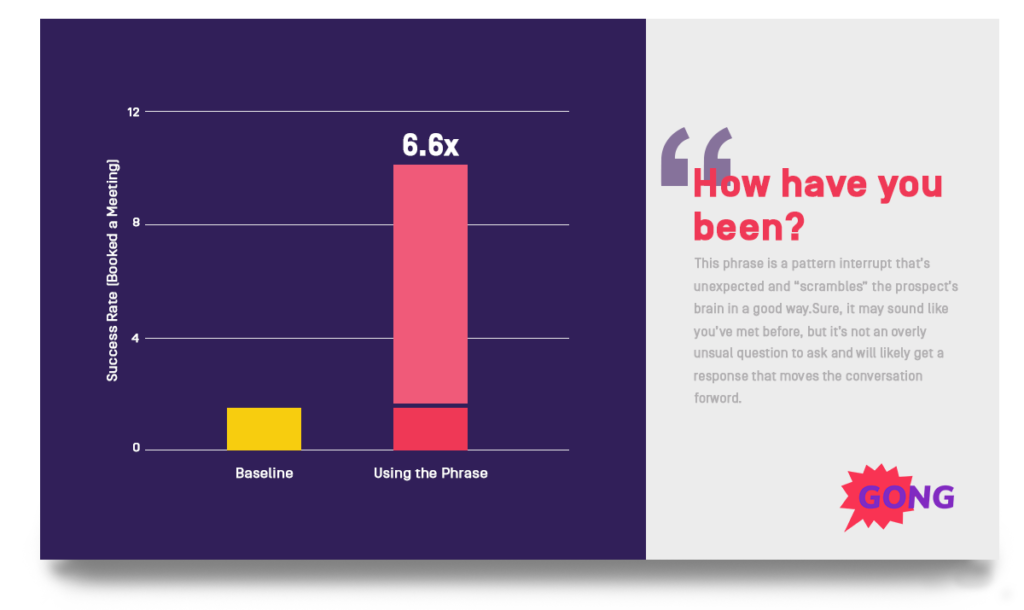
So why does this technique work so well?
Two words: Pattern. Interrupt.
A pattern interrupt is something unexpected that “scrambles” your prospect’s brain. Something totally unlike the typical “have I caught you at a good time?” they usually get from the average cold caller.
Prospects expect certain responses from salespeople. By breaking these natural assumptions and defying expectations, you can make your prospects more receptive.
Give this idea a spin for yourself. Sure, it may feel a tad awkward at first. But wait until you see the results.
PS: We analyzed 100,000+ outbound, connected cold calls to show you what top reps do to get to the next stage in the buying cycle. Curious? Download the free printable cold calling script.
Technique #2: Use Your Full Name + Company Name
When you call a prospect and forget to state your name and the company you’re with, what’s the first thing they tend to ask? (Hint: It’s not “where do I sign up?!”)
It’s “Who is this?” or “What company are you with?”
Which puts you on a defensive footing right at the beginning of your sales call. You know, the part of your sales prospecting process where you’re trying to build trust and goodwill.
Not a good start.
Do this instead:
“Hi Kate, this is Jonathan Costet calling from Gong…”
So much better. Why?
Two reasons this tip works so well…
First, people who introduce themselves with their full name command respect. They’re important. Who would you respect more – Jon or Jonathan Costet? (It’s fine, I won’t get offended).
Second, the person who asks the questions controls the conversation. You control the conversation when you state your name and your company’s name up front, because the next question comes from you. It’s not “who is this?”
Technique #3: Avoid This Prospecting Mistake
What mistake is that?
Asking “Did I catch you at a bad time?” at the beginning of a sales call.
As in: “Hi John. This is Corey Cold Caller from Spammy Inc. Did I catch you at a bad time?”
Shudder.
We know, we know.
There are plenty of sales experts that push for this (good ones too!). The idea behind it is that people like to say “no” so they can feel in control. And when you ask, “Did I catch you at a bad time?” they want to say “no.”
And the rest is gravy, right?
In theory, maybe.
But our data says otherwise. Opening your cold call with “Did I catch you at a bad time?” makes you 40% less likely to book a meeting.
Cold calls that opened with this line had a dismal 0.9% success rate:
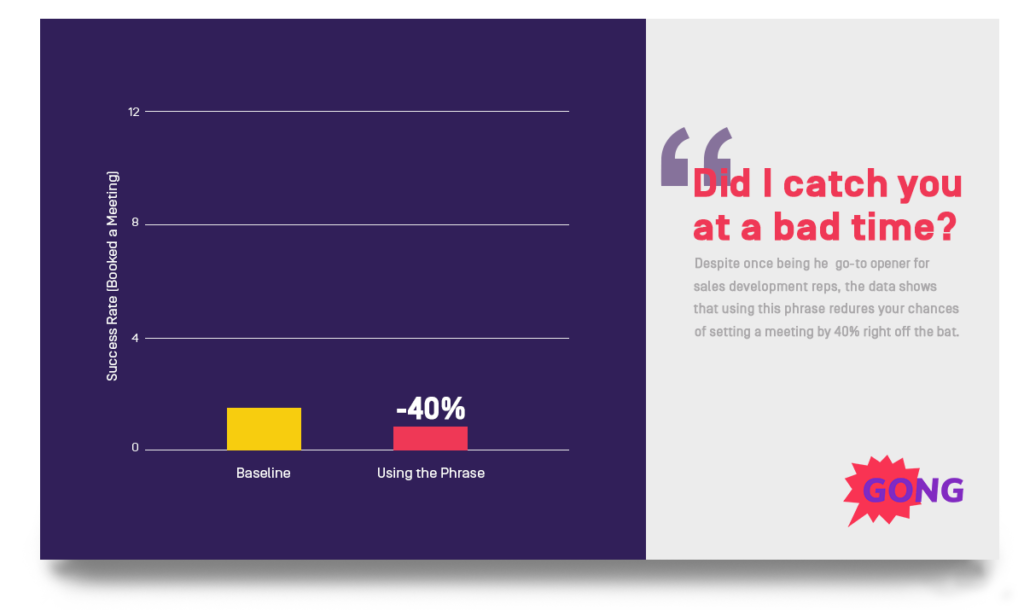
Why? Because everyone else does it. It’s common. It makes you sound like a typical sales rep.
And typical sales reps get treated like… typical sales reps, right?
Technique #4: State the Reason For Your Call
Let’s recap.
So far, your prospecting game is on-point. You’ve opened with your full name and company name and asked “How’ve you been?” And you’ve refrained from asking if you’ve caught them at a bad time.
Now it’s time to state the reason for your call. Why?
Put yourself in your buyer’s shoes. As soon as they answer the phone, their mind will race, wondering why you’re calling.
We all crave reasons. We want to know why things are the way they are. And receiving an unexpected call is no exception.
In fact, our research shows a 2.1X higher success rate for sales reps who state their reason for calling.
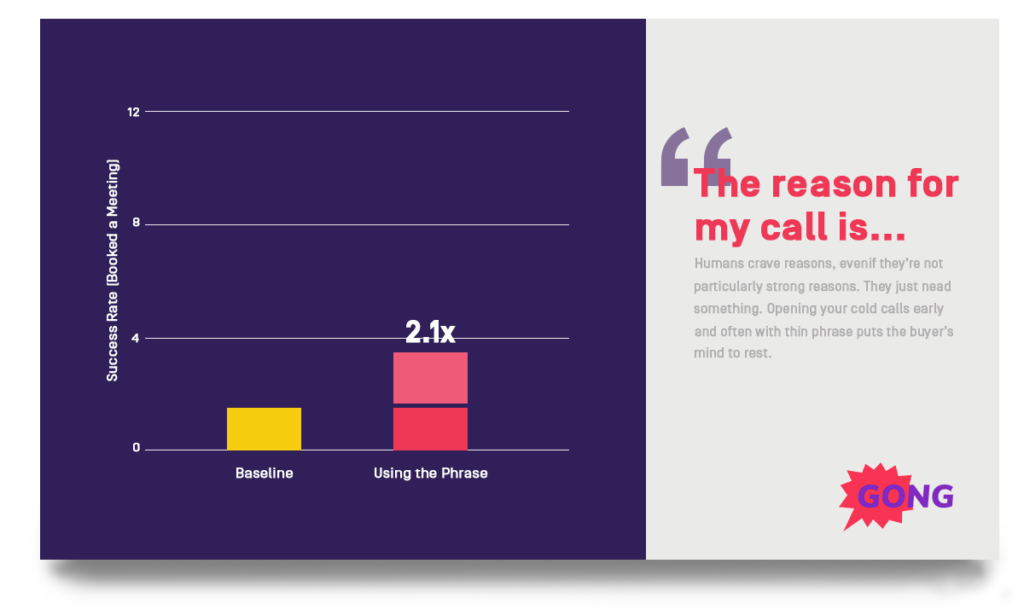
So, give your buyers the reasons that they crave.
“Hi Kate, this is Jonathan Costet with Gong.io. How’ve you been?”
(Kate answers).
“Kate, the reason I’m calling is…” and then give your reason.
Upfront. No awkward. Much meetings.
Here are 6 more cold calling examples to use in your next call blitz.
Technique #5: Keep Them on the Line
The hard truth about sales prospecting:
When your buyer answers your call, you have 5 seconds to earn 5 minutes.
Successful cold calls are almost twice as long as unsuccessful cold calls.
Rule number one: buy as much time as you possibly can. Prospecting isn’t just about getting your buyer’s attention. It’s about holding it.
The longer the call, the greater your odds of getting the meeting.
Successful cold calls that led to more meetings booked were 5 minutes and 50 seconds long. In contrast, unsuccessful cold calls that didn’t go anywhere were 3 minutes and 14 seconds long.
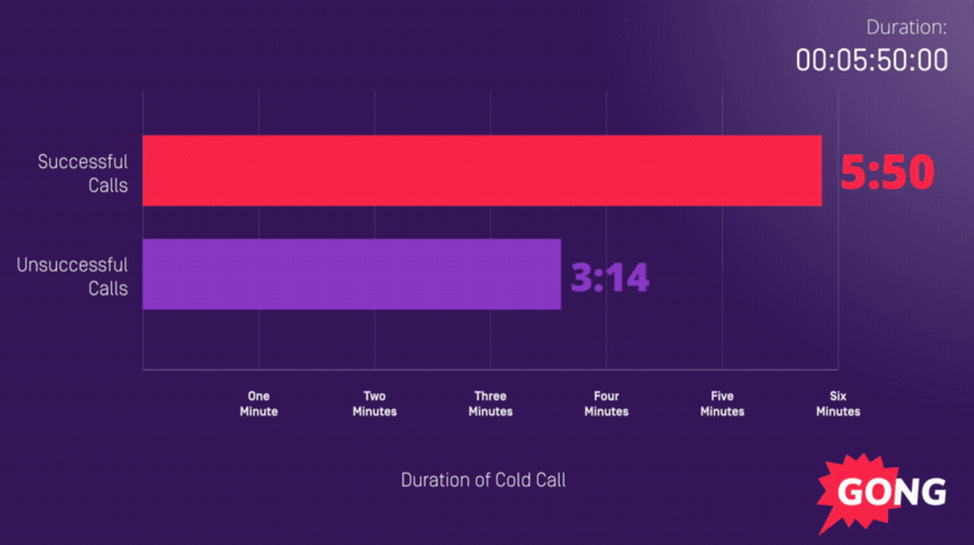
Get prospects to stay on the phone longer.
And the good news is that you’ve already had this same conversation hundreds of times.
You can predict the conversation “paths,” and how to navigate each one.
That means you have the power to plan every move in advance.

Every sentence out of your mouth should get the buyer to want to listen to your next sentence.
And that means your technique must be on point. Your choice of words needs to be economical and compelling in every way. Remove every unnecessary word from your sales script.
Here’s our tip: If it doesn’t add value to the conversation, then get rid.
Technique #6: Sell The Meeting
You know the “listen twice as much as you talk” rule?
Yeah, well that doesn’t apply to prospecting.
In fact, the talk-to-listen ratio for successful cold calls is higher than unsuccessful ones.
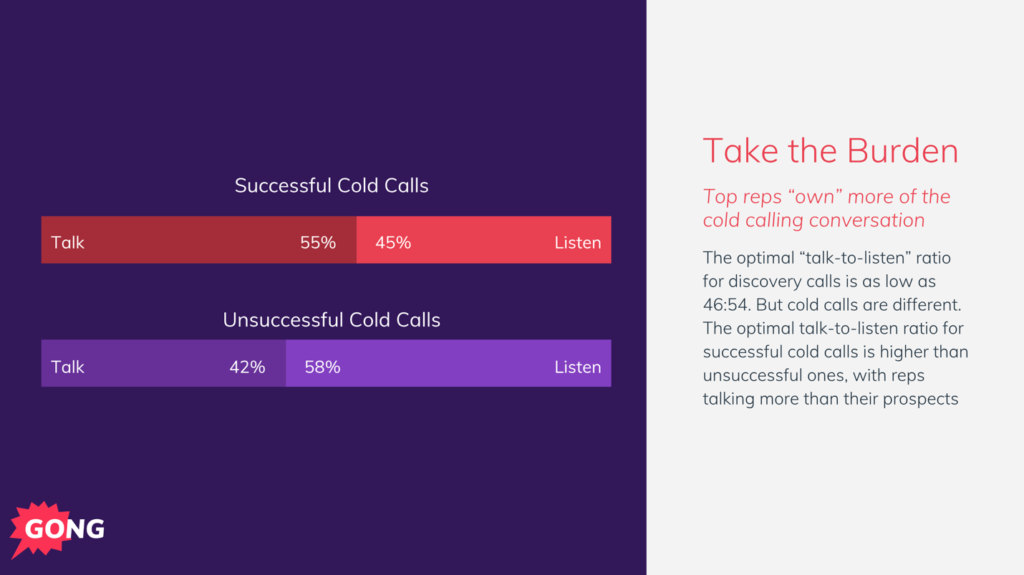
Cold outreach isn’t about discovery. It’s not about asking about their top strategic priorities.
It’s about selling your buyer on why they should attend the meeting. That’s when you’ll dig into their top priorities, and all that other good stuff!
Think about that idea for a second. Have you ever asked questions like “What are your top priorities?” in a cold call? Did your prospect respond with “I’m so glad someone finally asked me that!”?
Yeah, we didn’t think so.
Good sales technique, bad timing.
So avoid too much discovery early on in the sales process, and instead focus on selling the meeting.
Technique #7: Use This Question to Book More Meetings
There’s one question you should ask on every cold call you possibly can. The closing question that will help you book the meeting (remember, that’s the goal of sales prospecting, right?)
You’ve captured your buyer’s interest with your brilliantly researched, relevant questions. You’ve sold the meeting. They’re ready to take the next step.
Now it’s time to get that commitment for the meeting with “Do you have your calendar handy?”
Not “I’ll email you a link to my calendar,” or “let me know when you’re available to meet.”
No. Ask them to bring up their calendar, and get that meeting scheduled then and there.
It’s by far the best prospecting closing technique for a cold call we’ve seen.
Technique #8: Speaking of Booking Meetings, Use This Prospecting Email CTA
Writing effective sales prospecting emails is, well…really hard.
You have to craft the perfect subject line. You have to make it personalized and relevant. You have to have a compelling CTA.
None of these by themselves are easy to do. But to pull all of them off at once?!
Every part of a cold prospecting email is important. But the right CTA can turn a cold prospect into a warm (or even hot) lead.
How? By asking for interest, not the meeting. Something like “Are you interested in learning more about X?”
Huh? Wasn’t tip #6 all about how the whole purpose of prospecting was to sell the meeting? Yes. Yes it was.
But this isn’t about what to do during a conversation with a real live human being on the phone. This is about crafting an amazing sales email.
They may seem like the same thing. But they’re not.
Our team of data scientists analyzed the CTAs for 304,174 emails. They wanted to know which ones led to a booked meeting within 10 days.
Here’s what they discovered.
The interest CTA (asking for interest, not a meeting) is the highest-performing call to action for cold emails.
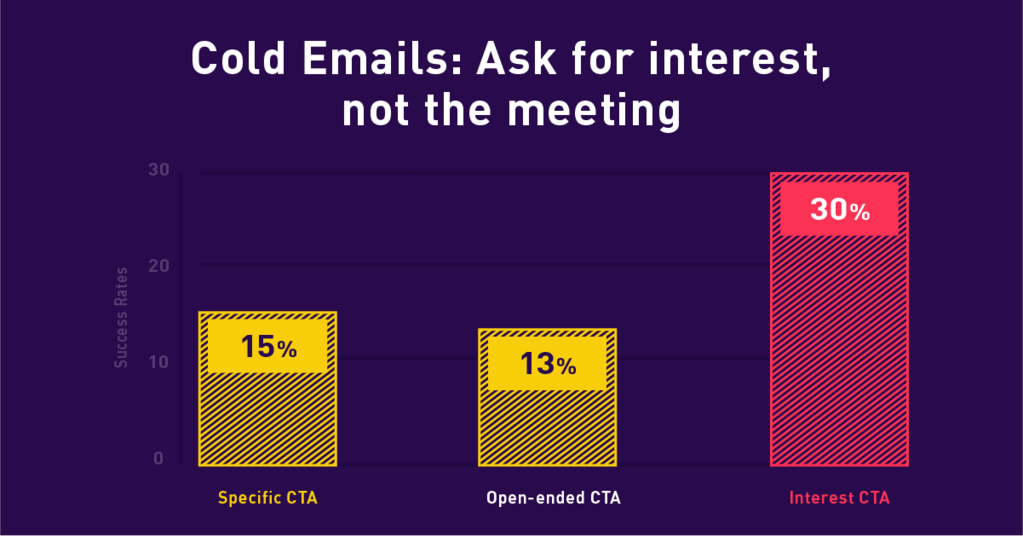
They’re about selling the conversation, not the meeting.
Think about it. Time is a scarce resource. And the decision makers you’re trying to entice in your cold outreach have less of it than ever before.
Yet here you are, a stranger, asking them for a chunk of that time.
How about no. Delete.
Asking for interest is different. Interest is not a scarce resource like time is. In fact, interest is really only limited by our own ability to tap into what matters most to our buyers.
This is why using an interest CTA to pique a buyer’s curiosity tends to work better than asking for time. There’s potentially much more of it to go around.
Want to master the art of sales prospecting? Book more meetings with these 43 irresistible CTA ideas. Download the cheat sheet now.
Technique #9: Do NOT Use This in Your Outreach Emails
What could be a more persuasive email pitch than the promise of a solid ROI? You know, statements like “increase revenue by 33%.”
Seems like something prospects would be impressed by, right?
Except here’s the problem—using ROI language in sales prospecting emails doesn’t work.
The Gong Labs team analyzed 132,552 cold emails to uncover how ROI language affects your success rates.
Note: We defined ROI language as the phrase “ROI” or any associated statistics (e.g., multipliers such as 2x, 2.5x, 30x; and percentages such as 5%, 23%, or 33%) in the sales rep’s email.
Our research shows that using ROI language in cold emails didn’t boost performance. In fact, it actually decreases success rates by 15%.
*gasp*
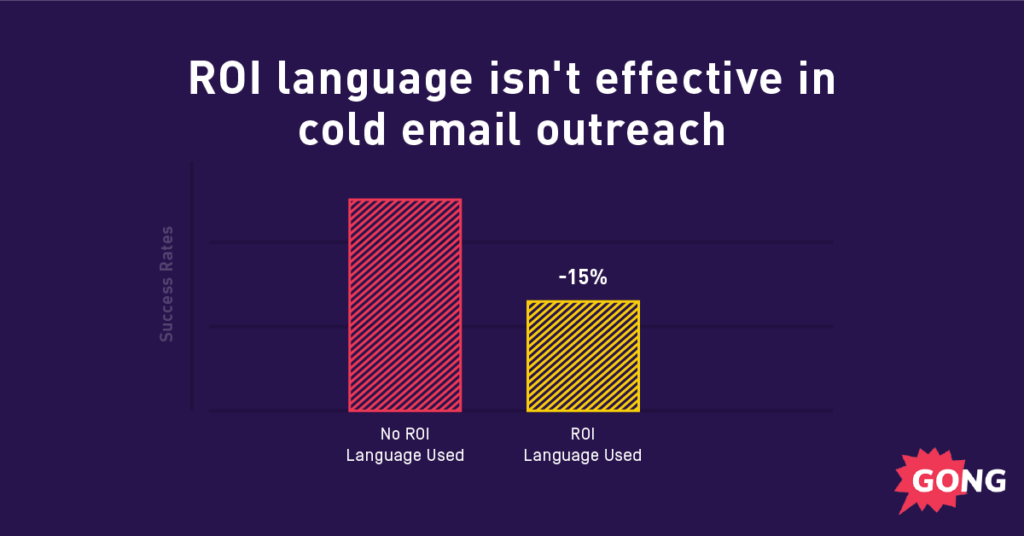
Counterintuitive? Hard to imagine why prospects would be less responsive to ROI data?
Think about it this way. Even if prospects believe your numbers are true (and that’s kind of a big if), they won’t necessarily find them persuasive enough to book a meeting with you.
That’s because ROI stats lack context. They’re unrelated to the tangible problems your prospects care about, and the emotions that problem stirs up in them.
Buyer’s make decisions based on emotions, and then they justify their decision with logic and facts—not the other way around. And starting with ROI skips over the critical “emotion” element.
So don’t do it. Leave the ROI claims out of your cold emails.
Need inspiration? Try these sales email templates to start writing irresistible emails.
Technique #10: Do Your Homework
With all the sales prospecting tools available to us in B2B sales today (from sales engagement to dialers), there’s no excuse for going into a cold call blind.
You have to do the research. You have to know about the company you’re going after, as well as relevant details about the person you’re contacting.
LinkedIn makes this easy. You’ll need to access to Sales Navigator, but the insights you’ll get are invaluable. Just take a look here:
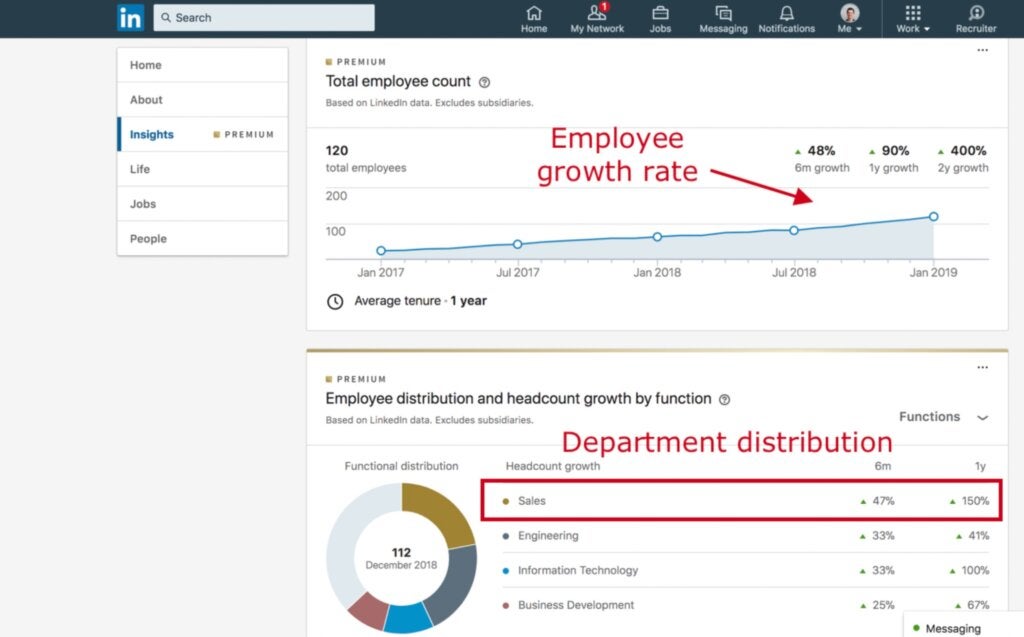
In just a few minutes, you can learn about how many people work at the account you’re targeting, the headcount per department, and the company’s growth rate.
For example, here at Gong, we need to know if a prospect company is growing fast. That means they probably have a sales onboarding challenge, and that’s a compelling business development problem Gong can address in our prospecting messages.
But don’t just stop at account research.
Use LinkedIn and other social media platforms hone in on specific people, and learn things from their profile that you may be able to use when you contact them. You can view their posts and comments to see what’s top of mind for them.
And you can even pick up on specific language they use in their profile and posts, and then make your message really resonate with them by using similar language in your email or cold call.
So, what kind of information will help you tailor your messaging when you reach out? Do your homework up front, and give yourself the insights you need to speak to your prospects’ relevant pain points.
Technique #11: Always follow up
You’ve researched the heck out of a prospect and fired off a great email.
One day goes by.
And then another.
But no response.
Not hearing back can be disheartening, especially after all the time you put into researching your sales prospects and personalizing your outreach.
Don’t take it too personally, though.
Buyers today are busy. They’re juggling multiple things at once, and many are “frazzled.” Just because you don’t hear back right away doesn’t mean they’re not interested.
Make sure to always, always follow up with prospects.
Here’s an example of a follow-up email you can send:
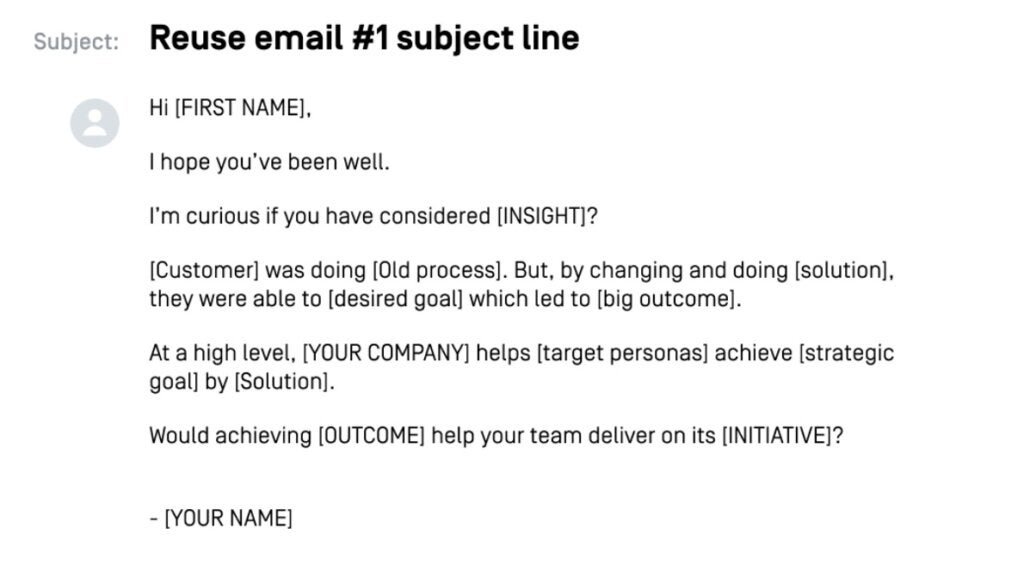
Here’s why this works:
First, longer emails perform 15x better than shorter ones.
Second, the CTA asks for interest, which is the highest-performing CTA for cold emails.
So give this follow-up email a try if you haven’t received a reply to your first email.
Grab even more sales follow-up emails here to elicit responses and keep deals moving.
Technique #12: Refine your sales prospecting process
What distinguishes the best sales organizations?
They constantly strive to improve their sales processes. Even when they find a talk track that works, they discover new ways to make it even better.
And they don’t stop there.
Successful sales leaders help their sales teams get more sales-ready, whether it’s helping them improve their outreach or nail their openers.
Track the following sales analytics to uncover valuable coaching opportunities:
- Phone calls made
- Emails sent
- Response rate
- Talk-to-listen ratios
- Questions asked
- Meetings booked
If a rep isn’t bringing deals, digging into their prospecting activities can help you figure out why. For example, are they listening more than talking on calls? Because that’s a major no-no.
In Tip #6, we mentioned that cold calls are more successful when reps talk more than their prospects. For this particular rep, you could coach them to speak more on their cold calls.
The key to booking more meetings is to continuously iterate your sales prospecting — test new sales methodologies, define your key performance indicators (KPIs), and revamp your sales onboarding.
Technique #13: Use a revenue intelligence platform
How do you know what messages resonate with your prospects? How do you know which deals are progressing and which need further attention?
To find these answers, you have two options: sift through hours and hours of your phone calls, or use a revenue intelligence platform — software that captures buyer interactions across different channels and delivers actionable insights.

Revenue intelligence delivers in-depth analytics into each conversation, allowing you to identify winning talk tracks that you can add to your sales playbook.
With a revenue intelligence platform, you get a reality-based view of your pipelines — identify areas where your reps can improve and get alerts for potential red flags on calls so that you can take steps to keep deals from stalling out.
Book a demo to learn how you can take your prospecting efforts to new heights with Gong’s revenue intelligence platform.
Become A Sales Prospecting Machine
Cold calls? Not a problem.
Sales cadences? Easy.
Writing sales copy that actually sells? Harder.
I put together the 7 laws highly effective sales emails all have in common.
Now you’ll forget all about prospects giving getting the unread treatment.

